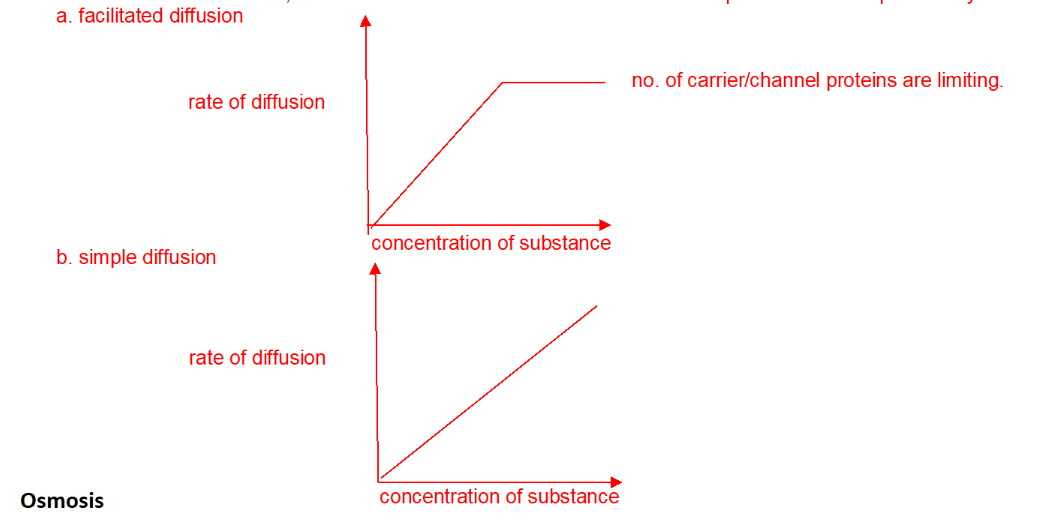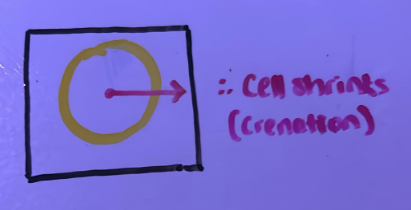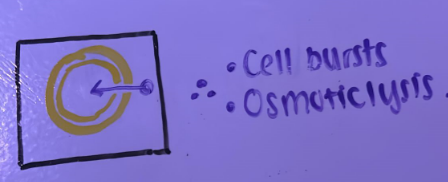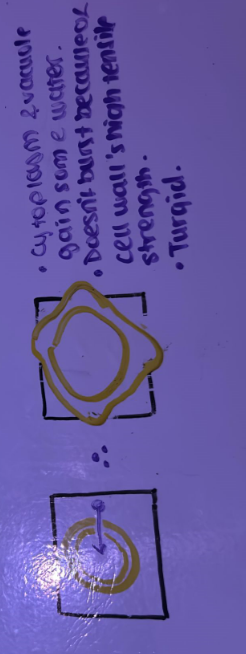CELL TRANSPORT:
1/32
There's no tags or description
Looks like no tags are added yet.
Name | Mastery | Learn | Test | Matching | Spaced |
|---|
No study sessions yet.
33 Terms
WHERE IS THE PLASMA MEMBRANE?
All cells are surrounded by the plasma membrane.
WHAT ARE THE UFNCTIONS OF THE PLASMA MEMBRANE?
Control transport of substances in and out of the cell/organelle.
They are partially permeable.
Act as a receptor site to recognise chemicals which need to enter cells/organelles.
Seperate off the cell from the environment and the different reactions of the cell from each other - compartmentalisation.
Different concentrations can be maintained on either side of the membrane.
Isolates organelles from the rest of the cytoplasm.
Site of biochemical reactions.
Allows cells to change shapes.
WHICH SUBSTANCES MUST ENTER AND LEAVE THE CELL?
Water.
CO2.
O.
Glucose.
WHAT IS THE DIFFERENCE BETWEEN A CELL WALL AND A CELL MEMBRANE?
Wall is thicker.
Wall is freely permeable because it contains ‘large’ pores.
Wall is made of cellulose.
WHAT DO MEMBRANES NOT ALLOW TO PASS THROUGH?
WHAT DOES THIS MEAN?
Water soluble (opposite is lipid soluble), charged/polar, large.
This is why the C-SM acts as an effective barrier to seperate the cell from its environement.
This suggsests that it contains lipids as they dotn mix with water.
HOW THICK IS THE C-SM?
~7nm wide.
WHY IS IT KNOWN AS A FLUID-MOSIAC STRUCTURE?
Fluid - All the different molecules can move around.
Mosaic - There are different types of molecule - the protein and carbohydrates ‘float around’ within the phospholipid bilayer.
CHANNEL PROTEINS?
Have hydrophilic channels in the middle to allow transport of substances.
WHAT FUNCTIONS MAY MEMBRANE PROTEINS HAVE?
INTRINSIC:
Transport channel and carriers.
EXTRINSIC:
Enzymes e.g. maltase.
Receptors - for binding to hormones etc. (tole in cell signaling).
Antigens - for cell recognition.
WHAT IS THE ROLE OF GLYCOPROTEINS IN THE C-SM?
(Cell signaling and cell receptors.)
Short, branching carbohydrate chains are attached to proteins in the membrane.
Receptors for hormones and neurotransmitters or antigens.
WHAT IS THE ROLE OF GLYCOPLIPIDS IN THE C-SM?
Made up of carbohydrates covalently bonded to a lipid.
Recognition sites, help to maintain the stability of the membrane.
Helps cells attach to one another to form tissues.
WHAT IS THE ROLE OF CHOLESTEROL IN THE C-SM?
C27H460.
Restricts the movement of other molecules that make up the membrane.
Increases stability and strength of membrane by making them less flexible.
Helps prevent loss of water and dissolved ions from the cell.
WHAT CAN MOLECULES IN THE C-SM DO?
Move laterally about the membrane.
Leave the membrane to form vesicles in the cytoplasm.
Join the membrane from vesicles in the cytoplasm.
WHAT PROPERTY DO CELLS HAVE DUE TO BEING FLUID?
Can change shape, e.g. for phagocytosis.
WHICH ORGANELLLES HAVE SINGLE PHOSPHOLIPID BILAYERS?
WHICH HAVE DOUBLE?
Vesicles, vacuoles, ER.
Mitochondria, chloroplasts, nucleus.
WHY IS THE PHOSPHOLIPID BILAYER NECASSARY?
It prevents the movement of water-soluble molecules and ions.
The aqueous contents of the cell are thus prevented from escaping.
WHAT DOES DIFFUSION RESULT IN?
Substances tend to reach a dynamic equilibrium where they are evenly spread, although still moving.
WHAT AFFECTS DIFFUSION (Not usual factors)?
Water solubility/polarity.
WHAT IS FICKS LAW?

HOW MAY CELLS BE ADAPTED FOR RAPID TRANSPORT?
By an increase in protein channels and carrier proteins in the membrane.
HOW DO NON-POLAR MOLECULES DIFFUSE AND WHY?
OXYGEN?
Rapidly across the phospholipid bilayer.
Because they’re lipid soluble.
Oxygen = Very small AND non-polar :: very rapid.
WHY CAN SMALL MOLECULES DIFFUSE MORE EASILY?
WATER?
They can fit through the phospholipid molecules.
Water (even though it is polar) is very small :: rapid diffusion.
WHAT IS FACILLITATED DIFFUSION?
Facilitated by a protein.
Moves polar/charged (ions, glucose etc.)/hydrophilic.
Carrier/channel proteins.
WHAT ARE THE GRAPHS FOR DIFFUSION?

WHAT HAPPENS WHEN ANIMAL CELLS ARE PLACED IN WATER AND WHY?
Change in volume and shape.
No cell wall.
ANIMAL IN HYPERTONIC?

ANIMAL IN HYPOTONIC?
Cell bursts and swells.

WHAT HAPPENS WHEN PLANT CELLS ARE PLACED IN WATER?
Cell wall prevents a large change in volume or shape/taking in too much water and bursting.
PLANT IN HYPERTONIC?

PLANT IN HYPOTONIC?

DESCRIBE THE POLARITY, METHOD OF TRANSPORT, AND WHERE THEY TRANSPORT FOR:
LIPIDS.
GLUCOSE.
IONS.
WATER.
OXYGEN.
?
LIPIDS = NP / Phos / Simp
GLUCOSE = P+L / Channel/Carrier / FC/AT
IONS = P+C / Channel/Carrier / FC/AT
WATER = P+S / Phos / Osmo
OXYGEN = NP+S / Phos / Simp
WHAT ARE ENDOCYTOSIS AND EXOCYTOSIS USED FOR?
PROCESS?
Endo/Exocytosis (mass transport) both have the same process.
Used to transport large amounts of material across the membrane.
Requires ATP.
Cell makes vesicles (sac-like structures made from the plasma membrane).
Vesicles used to transport solids/liquids across the cell membrane into/out of cells.
WHAT IS CO-TRASPORT NEEDED FOR?
WHAT DOES IT REQUIRE?
To absorb glucose from the lumen of the intestines into the epithelial cells:
Requires a high [difference] of glucose in the lumen compared to the epithelial cells (for facilliatated diffusion).
But there is usually more glucose in the epithelial cells :: AT is needed.